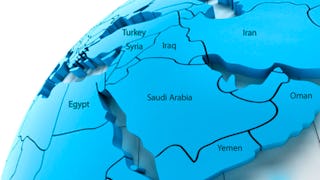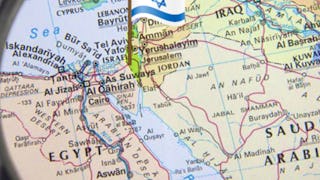Ce cours passera en revue l'émergence du Moyen-Orient moderne depuis la chute de l'Empire ottoman, à la fin de la Première Guerre mondiale, jusqu'à aujourd'hui. Nous discuterons de l'héritage ottoman dans la région et de l'impact impérial occidental sur la création du système étatique arabe. Le cours passera en revue la montée et le recul du nationalisme arabe, les problèmes de cohésion interne des États arabes, les questions de religion et d'État et l'évolution de la politique islamiste. Nous nous concentrerons également sur l'évolution du conflit israélo-arabe et son impact sur la région et nous conclurons par une analyse approfondie du "printemps arabe" en plaçant ces événements révolutionnaires contemporains dans leur contexte historique. Veuillez noter qu'il existe une deuxième partie à ce cours qui est une extension directe de cette partie. Nous vous recommandons vivement de poursuivre la deuxième partie après avoir terminé celle-ci (https://www.coursera.org/learn/modern-middle-east-2/home/info). Ce cours sera temporairement fermé aux inscriptions du 1er mars 2022 au 31 août 2022. Pendant cette période, le cours sera fermé aux nouvelles inscriptions. Tous les supports de cours resteront disponibles pour les apprenants déjà inscrits ; cependant, le personnel du cours ne fournira pas de soutien dans les forums de discussion pendant cette période.



L'émergence du Moyen-Orient moderne - Partie I

Instructeur : Professor Asher Susser
50 781 déjà inscrits
Inclus avec 
(1,146 avis)
Compétences que vous acquerrez
- Catégorie : Économie
- Catégorie : Gouvernance
- Catégorie : Histoire européenne
- Catégorie : Sciences politiques
- Catégorie : Histoire du monde
- Catégorie : Diversité culturelle
- Catégorie : Relations internationales
- Catégorie : Sciences sociales
Détails à connaître

Ajouter à votre profil LinkedIn
2 devoirs
Découvrez comment les employés des entreprises prestigieuses maîtrisent des compétences recherchées


Obtenez un certificat professionnel
Ajoutez cette qualification à votre profil LinkedIn ou à votre CV
Partagez-le sur les réseaux sociaux et dans votre évaluation de performance

Il y a 4 modules dans ce cours
Dans notre première leçon, nous situerons le Moyen-Orient dans le temps et dans l'espace. Nous apprendrons à connaître le Moyen-Orient du XIXe siècle, la structure de sa société et de son économie, ainsi que la dynamique de sa politique. Nous nous pencherons ensuite sur le changement spectaculaire qui s'est produit dans le dernier quart du XVIIIe siècle, à savoir le fossé qui s'est creusé entre l'Europe et le Moyen-Orient, et nous nous attarderons sur l'impact que ce changement a eu sur l'avenir de la région. Nous conclurons notre première leçon par une discussion sur la "question d'Orient", qui fait référence au sort de l'Empire ottoman et à l'équilibre des pouvoirs en Europe.
Inclus
9 vidéos2 lectures1 plugin
Notre deuxième leçon est une discussion sur les forces de la modernité et de la tradition au Moyen-Orient. Le filtrage des idées européennes au Moyen-Orient a engendré un processus de réforme dans la région pendant une grande partie du XIXe siècle. Nous analyserons deux centres de réforme à cet égard, à savoir l'Empire ottoman et l'Égypte. Cette analyse nous amènera ensuite aux réponses islamiques à la crise de la modernité résultant de la tension inhérente entre la foi et la laïcité. Nous verrons comment divers penseurs islamiques ont tenté de trouver un compromis entre ces tensions évidentes et se sont parfois orientés vers des directions plus fondamentalistes.
Inclus
11 vidéos1 lecture1 devoir
Dans la troisième leçon, nous assisterons à la montée du nationalisme au Moyen-Orient, qui est devenu une idée beaucoup plus acceptable à la fin du XIXe siècle et au début du XXe siècle parmi une minorité intellectuelle, élitiste et urbaine, diplômée d'écoles de type occidental (rappelez-vous la deuxième leçon et le processus de réforme !) Nous nous concentrerons sur l'émergence et le développement de trois mouvements nationalistes : turc, égyptien et arabe. Enfin, nous parlerons de la Première Guerre mondiale et de la façon dont elle a entraîné la fin de l'Empire ottoman ainsi que la fin de 400 ans de domination turque ottomane dans les pays arabes. Nous verrons également comment le Moyen-Orient a commencé à prendre sa forme actuelle après la Première Guerre mondiale.
Inclus
9 vidéos1 lecture
Dans notre quatrième leçon, nous parlerons de la création du système étatique du Moyen-Orient conformément aux plans britanniques et français après la Première Guerre mondiale. Tout d'abord, nous parlerons de l'Égypte et de la façon dont son développement historique distinct a donné lieu à une expérience libérale unique en Égypte au cours des années 1920 et 1930 et, par la suite, à une évolution constante vers l'islam et le nationalisme arabe. Ensuite, nous examinerons la région du Croissant fertile par rapport à l'Égypte et la création de mandats britanniques (Palestine, Trans-Jordanie, Irak) et français (Syrie, Grand Liban) dans cette région. Notre attention se portera ensuite sur les États non arabes. Nous découvrirons la création de la République de Turquie sur les ruines de l'Empire ottoman et le vaste processus de réforme modernisatrice sous Mustafa Kemal. Enfin, nous nous pencherons sur l'Iran qui, comme la Turquie, n'est pas un nouvel État créé par les grandes puissances, mais un pays doté d'une longue histoire et d'une longue tradition culturelle. Notre discussion sur l'Iran comprendra un aperçu de son histoire depuis le début du XVIe siècle ainsi que les principes de base du chiisme qui ont grandement façonné la culture politique en Iran.
Inclus
15 vidéos2 lectures1 devoir1 plugin
Instructeur

Offert par
En savoir plus sur Histoire


Tel Aviv University


Tel Aviv University


Universiteit Leiden
Pour quelles raisons les étudiants sur Coursera nous choisissent-ils pour leur carrière ?




Avis des étudiants
1 146 avis
- 5 stars
78,90 %
- 4 stars
17,78 %
- 3 stars
2,61 %
- 2 stars
0,17 %
- 1 star
0,52 %
Affichage de 3 sur 1146
Révisé le 1 sept. 2018
Great course with lots of information. I only wish that it was slightly longer and had time to go into some areas in more depth, but looking forward to part 2.
Révisé le 11 janv. 2016
Professor Susser organized a very well done course on a topic with very complex regional dynamics. In addition, the notes for each module were excellent!
Révisé le 7 sept. 2017
A complete breakdown of the Middle Eastern States emergence from the Ottoman Empire's rule to the Mandates imposted by the European Powers post WW1. Looking forward to part 2.

Ouvrez de nouvelles portes avec Coursera Plus
Accès illimité à 10,000+ cours de niveau international, projets pratiques et programmes de certification prêts à l'emploi - tous inclus dans votre abonnement.
Faites progresser votre carrière avec un diplôme en ligne
Obtenez un diplôme auprès d’universités de renommée mondiale - 100 % en ligne
Rejoignez plus de 3 400 entreprises mondiales qui ont choisi Coursera pour les affaires
Améliorez les compétences de vos employés pour exceller dans l’économie numérique
Foire Aux Questions
L'accès aux cours et aux devoirs dépend de votre type d'inscription. Si vous suivez un cours en mode audit, vous pourrez consulter gratuitement la plupart des supports de cours. Pour accéder aux devoirs notés et obtenir un certificat, vous devrez acheter l'expérience de certificat, pendant ou après votre audit. Si vous ne voyez pas l'option d'audit :
Il se peut que le cours ne propose pas d'option d'audit. Vous pouvez essayer un essai gratuit ou demander une aide financière.
Le cours peut proposer l'option "Cours complet, pas de certificat" à la place. Cette option vous permet de consulter tous les supports de cours, de soumettre les évaluations requises et d'obtenir une note finale. Cela signifie également que vous ne pourrez pas acheter un certificat d'expérience.
Lorsque vous achetez un certificat, vous avez accès à tous les supports de cours, y compris les devoirs notés. Une fois le cours terminé, votre certificat électronique sera ajouté à votre page de réalisations. Vous pourrez alors l'imprimer ou l'ajouter à votre profil LinkedIn. Si vous souhaitez uniquement lire et visualiser le contenu du cours, vous pouvez l'auditer gratuitement.
Vous pouvez prétendre à un remboursement intégral jusqu'à deux semaines après la date de votre paiement ou (pour les cours qui viennent d'être lancés) jusqu'à deux semaines après le début de la première session du cours, la date la plus tardive étant retenue. Vous ne pouvez pas obtenir de remboursement une fois que vous avez obtenu un certificat de cours, même si vous terminez le cours pendant la période de remboursement de deux semaines. Consultez notre politique de remboursement complète.
Plus de questions
Aide financière disponible,


